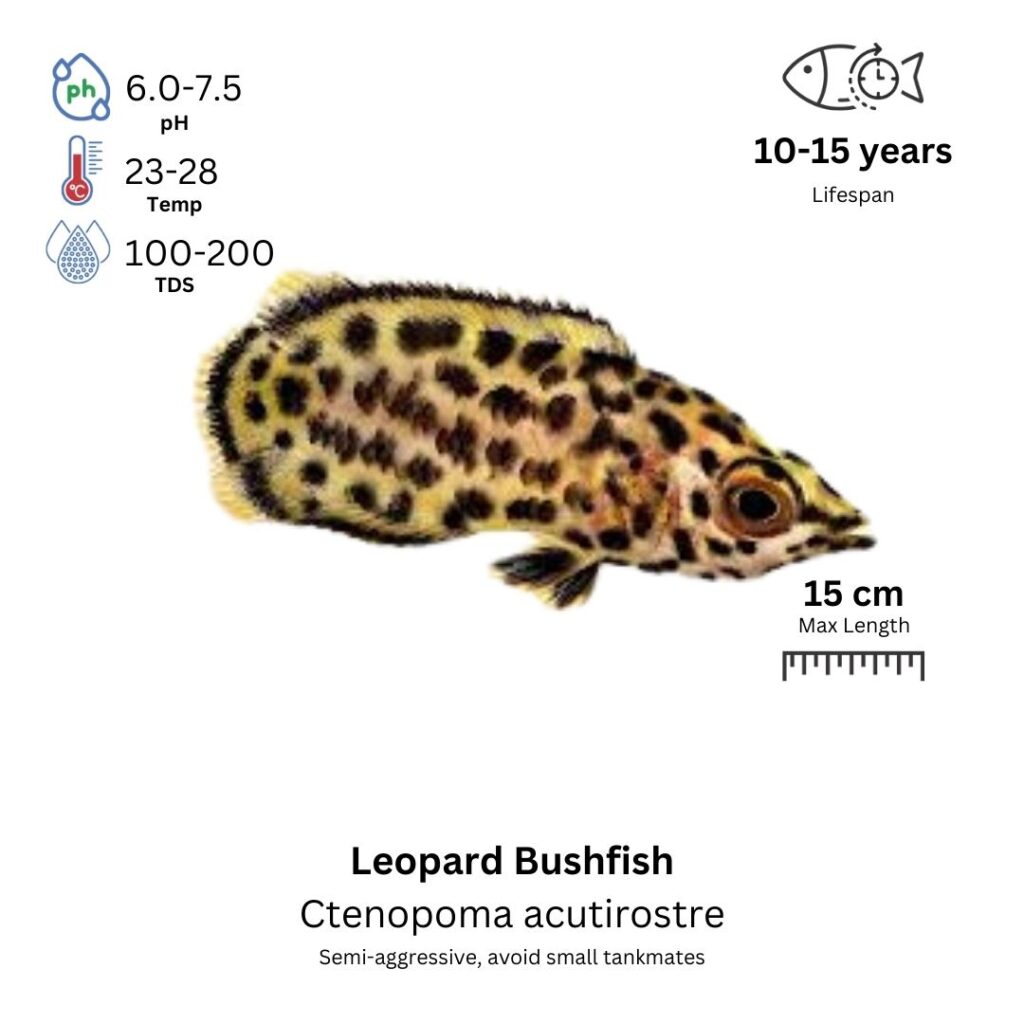Leopard Bushfish
Ctenopoma acutirostre

Description
The Leopard Bushfish is a stunning and unique species of freshwater fish known for its distinctive appearance and behaviors. It has an elongated, laterally compressed body with a pattern of dark spots and markings on a light brown to olive-colored background, resembling a leopard’s coat—hence the name. The markings are irregular and provide excellent camouflage in its natural habitat. The fish also has large, triangular pectoral fins and a large mouth, giving it a somewhat “piranha-like” appearance. As it grows, the Leopard Bushfish can develop a prominent head and strong, sharp spines along the dorsal fin.
Habitat Origin
Native to the slow-moving rivers and streams of West Africa, including regions in Cameroon and the Congo Basin. They are typically found in warm, shallow waters with abundant vegetation and submerged wood or rocks, which they use for hiding and ambushing prey. In the wild, they are often found in areas with low to moderate water flow, and they prefer slightly acidic to neutral water.
Aquarium
Ideal Number in Aquarium: Best kept singly or in pairs. Larger aquariums allow for more space if housed with other similar-sized fish.
Favorite Food

Leopard Bushfish are carnivores and will accept a variety of meaty foods. They primarily hunt live or frozen foods such as brine shrimp, bloodworms, daphnia, and small fish. In captivity, they can be fed high-quality pellets or frozen foods, as well as occasional live prey. It’s important to provide them with a protein-rich diet to mimic their natural hunting behavior and keep them healthy.
Behavior:
Leopard Bushfish are semi-aggressive and territorial, particularly around food and shelter. While they are not constantly aggressive, they do best in tanks with similarly sized fish that can hold their own. They tend to be more active at night, using their predatory instincts to hunt smaller fish or invertebrates. They can be quite shy and secretive during the day but become more active and confident when the lights are dimmed. This species is known to dig and rearrange the substrate, creating hiding spots in the tank. It is important to ensure that the aquarium has plenty of decorations, caves, and plant cover to allow the fish to feel secure and establish territories.
Special Care:
Leopard Bushfish are relatively hardy, but they need stable water conditions to thrive. They should be kept in tanks with good filtration and regular water changes. Providing plenty of hiding spots, rocks, and plants is essential, as this species is prone to stress if it feels exposed. Since they are nocturnal and territorial, a tank with strong visual barriers (such as dense plant growth or rock structures) can help prevent aggression and make them feel more secure.
Compatibility with Other Fish:
Leopard Bushfish are best kept with similarly sized, semi-aggressive fish. They can be housed with other medium-sized cichlids, larger tetras, or peaceful barbs, as long as the tank is large enough to provide enough territories for all the fish. It is important to avoid keeping them with smaller fish, as the Leopard Bushfish may view them as food. They are also not suitable tankmates for extremely aggressive species that could intimidate them. If housed with other species, ensure there are enough hiding spots and space for each fish to establish its own territory.
Breeding Setup
A separate breeding tank is strongly recommended for Leopard Bushfish due to their territorial behavior. A 100-liter (26-gallon) tank provides enough space for a breeding pair and helps maintain optimal water conditions. Maintain pH 6.5–7.5, temperature 26–30°C, and GH 4–12 dGH. Use a gentle sponge or internal filter with low flow to prevent disturbing the fish. Incorporate fine sand or gravel, and include live plants such as Java moss or Anubias to offer spawning sites and shelter. Moderate lighting that mimics their natural, shaded habitat is ideal.
Conditioning for Breeding
To condition Leopard Bushfish, feed them a high-protein diet of live and frozen foods, including brine shrimp, daphnia, bloodworms, and mysis shrimp. Supplement with high-quality carnivore pellets. This nutritional boost prepares the fish for reproduction. Maintain weekly 25% water changes to ensure clean, stable water, which is essential for stimulating breeding behavior and supporting the health of both sexes.
Spawning Process
Leopard Bushfish are egg layers, and spawning usually occurs during evening or early morning. The male initiates courtship with colorful displays and a “shimmy” dance. The female lays 100–300 eggs on flat surfaces, plants, or rocks, which are then fertilized by the male. Post-spawning, promptly remove both adults to avoid predation on the eggs. While not all pairs exhibit egg-eating behavior, caution is advised to protect the developing embryos.
Fry Care
Eggs hatch in about 2–3 days, and the fry remain near the hatching site until they absorb their yolk sacs. Once free-swimming, begin feeding them infusoria or liquid fry food, transitioning to baby brine shrimp after a few days. As they grow, introduce finely crushed pellets or small live foods. Perform daily 10–15% water changes, keeping the temperature stable at 26–30°C, and monitor for harmful toxins to ensure healthy development.
Important Notes
Leopard Bushfish typically reach sexual maturity at 12–18 months. Males are more colorful and slender, with longer fins, while females appear rounder, especially when gravid. To avoid stress, ensure plenty of hiding places and visual barriers, and refrain from overcrowding or housing them with aggressive species. A calm, well-maintained tank promotes successful breeding and fry survival.
